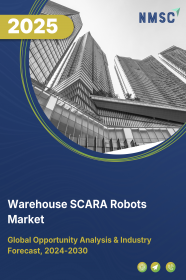
Articulated Robot Market by Type (4-Axis or Less, 5-Axis, and 6-Axis or More), by Payload (Upto 16 Kg, 16 to 60 Kg, 60 to 225 Kg and More Than 225 Kg), by Component (Controller, Arm, End Effector, Drive, Sensor, and Others), by Function (Handling, Welding, Dispensing, Assembly, Processing, and Others), and Others- Global Opportunity Analysis and Industry Forecast 2024-2030
Market Definition
The Articulated Robot Market size was valued at USD 16.70 billion in 2023 and is predicted to reach USD 43.09 billion by 2030 with a CAGR of 14.5% from 2024-2030. Articulated robot is a type of robotic system designed with multiple interconnected joints or segments, resembling the flexibility and range of motion of a human arm. These robots are designed to perform a wide variety of tasks by bending, rotating, and extending their joints, allowing them to reach different positions and orientations.
Articulated robot are equipped with an end effector, such as a gripper, welding tool, or sensor, at the end of their arm to perform specific functions. Articulated robot finds widespread application across various industry sectors, including automotive, and manufacturing. They also find utility in medical surgery, laboratory automation, and even space exploration, where their ability to manipulate tools and equipment in challenging environments is invaluable.
Market Dynamics and Trends
The growing adoption of robotic solutions for automation across industries such as automotive, electronics, and manufacturing is driving the growth of the articulated robot market. These robots are being used to enhance efficiency, reduce labor costs, and improve product quality.
According to the latest report from the International Federation of Robotics, the automotive industry is the largest user of robots, including articulated robots, with installations reaching about one million units in 2022. Moreover, the substantial growth of e-commerce worldwide is leading to a significant surge in the demand for automation and robotics.
As per the latest report published by the International Trade Administration, the global e-commerce sector is experiencing substantial growth, with projections indicating a market size of USD 5.5 trillion by 2027. This surge in e-commerce activity drives the demand for efficient and reliable warehouse operations such as packaging, and shipping procedures, further boosting the demand for articulated robot.
Furthermore, advancements in technology, such as artificial intelligence and computer vision, are enhancing the intelligence and efficiency of articulated robots. This enables them to perform complex tasks and adapt to dynamic environments more effectively.
As a result, the growth of the market is further boosted, as these advancements increase the versatility and capabilities of articulated robots across various industries. However, high initial cost associated with articulated robot are expected to restrain the growth of the articulated robot market.
On the contrary, the introduction of soft and vacuum grippers that enables the handling of delicate and fragile products without causing damage or scuff marks are anticipated to create ample growth opportunities for the articulated robot market in the coming years.
For instance, in September 2022, The Gripper Company launched MaxxGrip, a versatile gripper designed to enhance robotic handling capabilities. MaxxGrip offers improved gripping performance, contributing to more efficient automation solutions in numerous industries.
Market Segmentations and Scope of the Study
The articulated robot market share is segmented on the basis of type, payload, component, function, end user and region. On the basis of type, the market is classified into 4-axis or less, 5-axis and 6-axis or more. On the basis of payload, the market is categorized into upto 16 kg, 16 to 60 kg, 60 to 225 kg and more than 225 kg. On the basis of component, the market is divided into controller, arm, end effector, drive, sensor and others. On the basis of function, the market is segmented into handling, welding, dispensing, assembly, processing, and others. On the basis of end user, the market is bifurcated into automotive, electrical & electronics, chemicals, rubbers & plastics, metal & machinery, food & beverages, pharmaceuticals & cosmetics, and others. Regional breakdown and analysis of each of the aforesaid segments includes regions comprising of North America, Europe, Asia-Pacific, and RoW.
Geographical Analysis
North America holds the dominant share of articulated robot market at present and is expected to continue its dominance during the forecast period. The growing adoption of robotics in the automotive industry is fueling the expansion of the articulated robot market in North America.
According to the latest report from the International Federation of Robotics, the U.S. stands out as one of the leading countries adopting a large number of robots within its automotive sector, with a total of 1,457 robot operating in the automotive industry in 2023. This significant adoption is a driving the growth of the market.
Also, the rising initiatives by key market players such as Rockwell Automation, Inc, American Robot Corporation, and Honeywell International, Inc. in terms.strategies inclusing product launches. These efforts are shaping the landscape of the articulated robot’s market and also catering to the evolving needs of industries seeking precision, efficiency, and flexibility in their manufacturing processes.
For instance, in September 2021, Honeywell launched the Smart Flexible Depalletizer, a robotic solution designed to automate pallet unloading in warehouses and distribution centers. It uses advanced vision and perception technology along with an articulated robotic arm to handle cases from mixed or single pallets, whether they're stationary or mobile.
On the other hand, Asia-Pacific is expected to show a steady rise in the articulated robot market due to the rising government initiatives towards automation across countries such as Singapore, China, and Japan. For instance, in September 2021, the Singaporean government launched the Integrated Robotics & Automation Solutions initiative, aimed at promoting the adoption of robotics and automation in the country.
This initiative harnesses artificial intelligence (AI), automation, and advanced systems to enhance safety, streamline routine tasks, and boost productivity for numerous industries. As the adoption of robot continues to grow, the demand for articulated robot is poised to rise, boosting the growth of the market in this region.
Moreover, the presence of key robotics companies such as Yaskawa Electric Company and Kawasaki Heavy Industries, Ltd. in countries such as Japan, China, and South Korea is driving the growth of the articulated robot market.
For instance, in April 2022, Yaskawa Electric Company launched latest industrial robot technology based on i3-technology, offering advanced automation solutions for various industries. Through this technology, Yaskawa aims to improve manufacturing processes and boost efficiency within the industrial sector, leading to an increased demand for articulated robot to optimize their operations.
Competitive Landscape
The various market players operating in the articulated robot includes ABB Ltd, FANUC Corp., KUKA, Yaskawa Electric Corporation, Kawasaki Heavy Industries, Ltd., Adept Technology Pvt. Ltd., American Robot Corporation, Rockwell Automation, Inc, Honeywell International, Inc., and Omron Adept Technology among others. These market players are adopting product launches as their key developmental strategies across countries to maintain their dominance in articulated robot market.
For instance, in October 2022, ABB launched its smallest articulate industrial robot, the IRB1010, to help meet smart device demand. The compact system is designed to help electronics manufacturers increase the production of devices such as smart watches, earphones, sensors, and health trackers.
Also, in January 2022, Fanuc launched a new M-1000iA articulate robot, capable of handling very heavy products including automotive components, construction materials and battery packs for electric vehicles. The M-1000iA is equipped with a 1,000 kg payload, 3,253 mm horizontal reach, and 4,297 mm vertical reach, that enables to work for firms to boost productivity and maximize efficiency of their production lines.
Key Benefits
-
The report provides quantitative analysis and estimations of the articulated robot market from 2024 to 2030, which assists in identifying the prevailing market opportunities.
-
The study comprises a deep-dive analysis of the articulated robot market including the current and future trends to depict prevalent investment pockets in the market.
-
Information related to key drivers, restraints, and opportunities and their impact on the articulated robot market is provided in the report.
-
Competitive analysis of the players, along with their market share is provided in the report.
-
SWOT analysis and Porters Five Forces model is elaborated in the study.
-
Value chain analysis in the market study provides a clear picture of roles of stakeholders.
Key Market Segments
By Type
-
4-Axis or Less
-
5-Axis
-
6-Axis or More
By Payload
-
Upto 16 Kg
-
16 to 60 Kg
-
60 to 225 Kg
-
More Than 225 Kg
By Component
-
Controller
-
Arm
-
End Effector
-
Drive
-
Sensor
-
Others
By Function
-
Handling
-
Welding
-
Dispensing
-
Assembly
-
Processing
-
Others
By End User
-
Automotive
-
Electrical & Electronics
-
Chemicals
-
Rubbers & Plastics
-
Metal & Machinery
-
Food & Beverages
-
Pharmaceuticals & Cosmetics
-
Others
By Region
-
North America
-
The U.S
-
Canada
-
Mexico
-
-
Europe
-
The UK
-
Germany
-
France
-
Italy
-
Spain
-
Denmark
-
Netherlands
-
Finland
-
Sweden
-
Norway
-
Russia
-
Rest of Europe
-
-
Asia-Pacific
-
China
-
Japan
-
India
-
South Korea
-
Australia
-
Indonesia
-
Singapore
-
Taiwan
-
Thailand
-
Rest of Asia-Pacific
-
-
RoW
-
Latin America
-
Middle East
-
Africa
-
Key Players
-
ABB Ltd
-
FANUC Corp.
-
KUKA
-
Yaskawa Electric Corporation
-
Kawasaki Heavy Industries Ltd.
-
Adept Technology Pvt. Ltd.
-
American Robot Corporation
-
Rockwell Automation Inc.
-
Honeywell International Inc.
-
Omron Adept Technology
REPORT SCOPE AND SEGMENTATION:
|
Parameters |
Details |
|
Market Size in 2023 |
USD 16.70 Billion |
|
Revenue Forecast in 2030 |
USD 43.09 Billion |
|
Growth Rate |
CAGR of 14.5% from 2024 to 2030 |
|
Analysis Period |
2023–2030 |
|
Base Year Considered |
2023 |
|
Forecast Period |
2024–2030 |
|
Market Size Estimation |
Billion (USD) |
|
Growth Factors |
|
|
Countries Covered |
28 |
|
Companies Profiled |
10 |
|
Market Share |
Available for 10 companies |
|
Customization Scope |
Free customization (equivalent up to 80 working hours of analysts) after purchase. Addition or alteration to country, regional, and segment scope. |
|
Pricing and Purchase Options |
Avail customized purchase options to meet your exact research needs. |




















 Speak to Our Analyst
Speak to Our Analyst

























